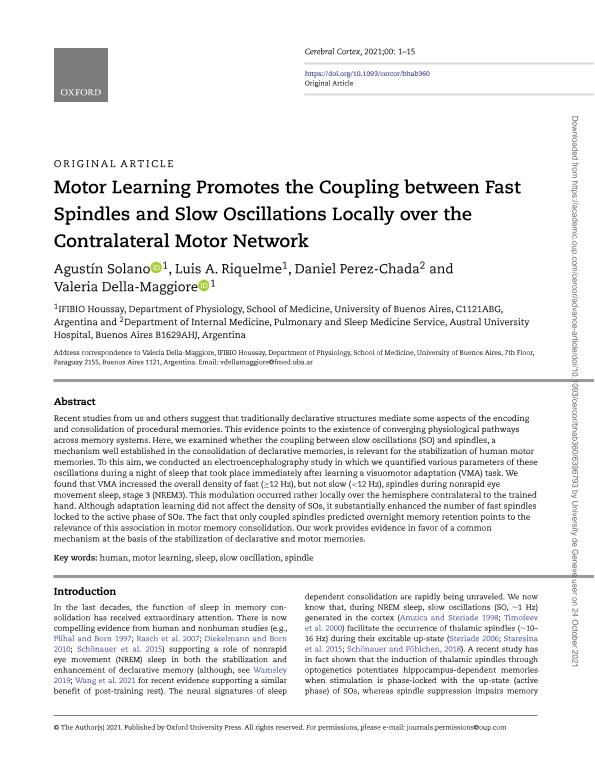Artículo
Motor Learning Promotes the Coupling between Fast Spindles and Slow Oscillations Locally over the Contralateral Motor Network
Solano, Agustín Benjamín Ezequiel ; Riquelme, Luis Alberto; Pérez Chada, Daniel; Della Maggiore, Valeria Monica
; Riquelme, Luis Alberto; Pérez Chada, Daniel; Della Maggiore, Valeria Monica
 ; Riquelme, Luis Alberto; Pérez Chada, Daniel; Della Maggiore, Valeria Monica
; Riquelme, Luis Alberto; Pérez Chada, Daniel; Della Maggiore, Valeria Monica
Fecha de publicación:
10/2021
Editorial:
Oxford Univ Press Inc
Revista:
Cerebral Cortex
ISSN:
1047-3211
Idioma:
Inglés
Tipo de recurso:
Artículo publicado
Clasificación temática:
Resumen
Recent studies from us and others suggest that traditionally declarative structures mediate some aspects of the encoding and consolidation of procedural memories. This evidence points to the existence of converging physiological pathways across memory systems. Here, we examined whether the coupling between slow oscillations (SO) and spindles, a mechanism well established in the consolidation of declarative memories, is relevant for the stabilization of human motor memories. To this aim, we conducted an electroencephalography study in which we quantified various parameters of these oscillations during a night of sleep that took place immediately after learning a visuomotor adaptation (VMA) task. We found that VMA increased the overall density of fast (≥12 Hz), but not slow (<12 Hz), spindles during nonrapid eye movement sleep, stage 3 (NREM3). This modulation occurred rather locally over the hemisphere contralateral to the trained hand. Although adaptation learning did not affect the density of SOs, it substantially enhanced the number of fast spindles locked to the active phase of SOs. The fact that only coupled spindles predicted overnight memory retention points to the relevance of this association in motor memory consolidation. Our work provides evidence in favor of a common mechanism at the basis of the stabilization of declarative and motor memories.
Palabras clave:
HUMAN
,
MOTOR LEARNING
,
SLEEP
,
SLOW OSCILLATION
,
SPINDLE
Archivos asociados
Licencia
Identificadores
Colecciones
Articulos(IFIBIO HOUSSAY)
Articulos de INSTITUTO DE FISIOLOGIA Y BIOFISICA BERNARDO HOUSSAY
Articulos de INSTITUTO DE FISIOLOGIA Y BIOFISICA BERNARDO HOUSSAY
Citación
Solano, Agustín Benjamín Ezequiel; Riquelme, Luis Alberto; Pérez Chada, Daniel; Della Maggiore, Valeria Monica; Motor Learning Promotes the Coupling between Fast Spindles and Slow Oscillations Locally over the Contralateral Motor Network; Oxford Univ Press Inc; Cerebral Cortex; 32; 12; 10-2021; 2493-2507
Compartir
Altmétricas



